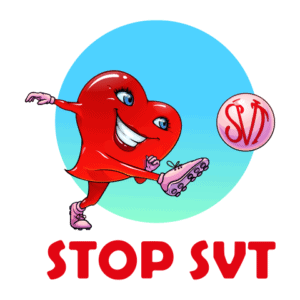Living with supraventricular tachycardia is challenging.
It doesn’t matter if you experience minor or major symptoms, if you are aware of your SVT for only a couple of days or for decades. Either way, the simple idea that there are things like exercise that might trigger an SVT episode seriously challenge you and your approach to life.
I am an advocate of living life as fully as possible and not letting your fears limit you.
Even if there is the possibility of tachycardia being triggered after physical exertion, you don’t have to exclude movement from your life.
Lack of exercise will bring you more disadvantages than the symptoms of this condition.
So let’s go over a few things you can do to stay active and improve your heart health without exhausting yourself to the point of triggering SVT.
Training is one of the ways you can lower your heart rate over time. It will reduce the incidence of SVT episodes and make your heart stronger.
Table of Contents
Start With an Activity You Are Comfortable Doing One Minute a Day
I know working out can be intimidating when living with SVT and it makes sense.
If you work out hard, your heart rate jumps and that can lead to an episode.
Luckily, there are ways to go around this.
Answer the question: what physical exercise can I do today for 1 minute without my mind thinking that I will have an SVT episode?
Start with something easy for you.
It will probably be comfortable for you to take a 1-minute walk in front of the house without being stressed that your pulse will go wild.
Well, do this for a week every day. Walk right in front of your home, up and down the street, don’t go too far.
After a week, you will see that, in fact, in that minute you walked every day, nothing happened to you. You didn’t have an episode.
From the second week, you will have the courage to increase walking to 2-3 minutes a day.
Progressing in this way, you will, at some point, walk for 10 minutes in front of the house, and you will gain confidence that nothing catastrophic will happen.
You will admit that if nothing happened to you in these 10 minutes of walking and it is not such an end of the world to walk with SVT, then you will have more and more courage to go to the park for a short walk or to the beach or in any other place you want.
Spreading Your Workout Load Throughout The Day
Another thing you can do is divide your exercise program into a couple or more separate units.
You can start the day with a 15-minute stretching routine. This is quite stimulating and pumps you up much better than coffee ever did. At the same time it calms your mind and prepares you for all the challenges that lie ahead.
You can do the second session after you get home from work. This one is a bit more intense and dynamic and is a great way to destress yourself after work.
The last one is just before bed. It consists of slow, easy stretching exercises that make me flexible and ready for sleep.
If you worry that splitting your workload might reduce its effectiveness, various studies show that spreading your daily workout routine is just as effective as doing it all at once.
Redesign Your Exercises To Make Them Work For You
Working out seems frightening when you have SVT especially when you are about to begin.
You feel far from your optimal condition and it seems like any harder exercise might trigger an SVT attack.
However, you should know that there is more than one way to do a certain drill.
- If push-ups seem challenging, try doing them on your knees.
- If burpees are your kryptonite, use a bench as a support.
- If squats get you worked-up, stand your legs more apart, or try any of the variations from this link.
None of us has the same anatomy and what might be a piece of cake for you, might be climbing Mt. Everest for me. Experiment and take your time.
Reduce Your Sitting Periods to Protect Your Heart
Sitting is the new smoking.
Even if you work out regularly, sitting for longer periods of time can be detrimental for your heart and health overall.
Sitting for lengthy periods slows your circulation down, and can lead to plaque formation in your arteries. This potentially leads to heart disease.
Sitting also increases your insulin resistance, which makes you more susceptible to diabetes.
Also, people who sit a lot experience slowed metabolism, posture issues, osteoarthritis, and other conditions.
If your work involves a lot of sitting, try to take as many breaks as possible. Even for only a minute or so.
Instead of sitting at the desk, you can use a standing desk, or a convertible desk that allows you to alternate sitting and standing. Either way, try to intercept your sitting periods at least every 50 minutes.
Walking Is an Effective Work Out

Walking is a simple exercise you should incorporate into your daily routine. You can include various activities to keep your walking exercise routine fresh and fun while adding additional health benefits to it.
Walking In Nature – Forest Bathing
People are increasingly disconnected from nature. Which is odd, considering how each and every one of us experienced the calming effects of nature dwelling.
Various research shows that time spent in nature is nurturing not only for our minds, but also for our heart, our lungs, our immune system and even for our social connectedness.
A study done on people who were predisposed to hypertension showed that after a 2 hours forest walk, their heart rate decreased by 3%.
Another study found that walking in nature twice as much in the same day but in two different sessions decreased the participants’ heart rate with 6,9%.
Try to make a habit of going into nature, at least once in two weeks. And forests are not the only nature that counts. Mountains, rivers, oceans can all improve your wellbeing.
Grounding (Earthing) Can Have a Positive Effect on Your Heart
Having direct contact with the earth surface apparently has a profound effect on your health.
So it comes as a no surprise that earthing can have a protective effect for your cardiovascular health and your muscles.
Try to make a habit of walking barefoot, at least during warmer months, for only 10-15 minutes each day. I can guarantee that this period will grow by the day and that in a couple of weeks you will walk without your shoes as much as possible.
Walking On Cobblestones Lowers High Blood Pressure
Once you make walking barefoot a part of your daily routine, you can try walking on cobblestones or similar surfaces.
This might prove tricky and uncomfortable at first. If you persevere only a little bit, the soles of your feet will develop endurance and you will be able to glide over uneven surfaces as over clouds.
This will not only broaden the perimeter of you barefoot walking, but also lower your blood pressure and improve your overall health.
Mini Trampolines Promote Heart Health
Ok, I know. This one sounds kind of funny. But science backs it. One study demonstrates that using a mini trampoline compared to stationary running video games (comparable to treadmill) proved to be more intense and enhancing to physiologic responses. All of this means that a mini trampoline can improve your cardiovascular health and fitness levels better than a simple treadmill can and it is fun.
Take one piece of advice from here and implement it today.
I’m curious what exercise you decided to start with?


I am new to svt. Seems triggered by heavy exercise. I am in toprol 50 mg/day and Dr just raised to twice/ day. I’m
Interested in your thinking. Getting desperate here for relief!’
Hi Elizabeth,I suggest finding a holistic doctor who can help you to find the root cause. A holistic doctor is a medical professional who focuses on treating the whole person rather than just the isolated condition. These doctors are trained to look for the root of a problem, rather than simply reaching for a temporary fix. I hope you find a solution soon.
I am new to this SVT. I am on metoprolol tartrate 50mg twice a day. I am very interested in knowing everything about it. And what are some things I can do to prevent from having episodes. What exercises are good for me to do.
Hi Jessica, Welcome to the world of understanding SVT! Generally, staying hydrated, managing stress, and maintaining a balanced diet can help. Moderate exercises like walking might be beneficial to start with, but always consult with your doctor first. Best wishes on your health journey!